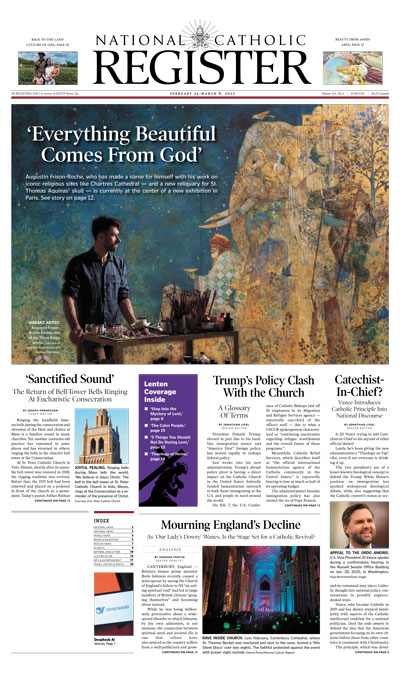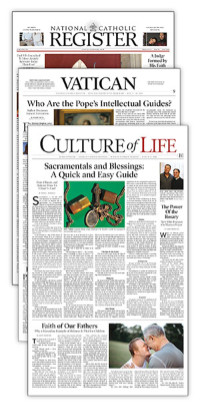Cardinal Re to Electors: Next Pope Must Strengthen Church as Our ‘Home and School of Communion’
COMMENTARY: Preaching, worship and charity aren’t rival qualities but form a unified mission — and the new pope must live and lead with all three.

Normality has returned to Rome. A pope dies, and the cardinals gather to elect a new one. In 2013, there was a conclave without a funeral. In 2023, there was a funeral, but no conclave. For the first time since 2005, both are back in the proper sequence.
In 2005, the Mass for the Election of the Roman Pontiff was celebrated by the dean of the College of Cardinals, Cardinal Joseph Ratzinger. The homily became instantly famous for its observation that “having a clear faith based on the Creed of the Church is often labeled as fundamentalism.”
“Whereas relativism, that is, letting oneself be ‘tossed here and there, carried about by every wind of doctrine,’ seems the only attitude that can cope with modern times,” Cardinal Ratzinger preached. “We are building a dictatorship of relativism that does not recognize anything as definitive and whose ultimate goal consists solely of one’s own ego and desires.”
Cardinal Ratzinger was elected about 30 hours after that homily, and in the 20 years since, evidence of the dictatorship of relativism has not been lacking. Yet it is another of his texts from 2005 that should guide the cardinal electors in the conclave.
In his first encyclical, Deus Caritas Est, dated Christmas Day, Benedict XVI wrote about the Church’s essential character, expressed in a triplex munera — meaning office, duty, ministry or responsibility.
“The Church’s deepest nature is expressed in her three-fold responsibility: of proclaiming the word of God (kerygma-martyria), celebrating the sacraments (leitourgia), and exercising the ministry of charity (diakonia). These duties presuppose each other and are inseparable,” Benedict wrote.
That is a helpful way to think about the ministry of Peter. The Holy Father must keep all three in balance, even if his strengths may lay in one more than the other. When Pope Francis was elected in 2013, the triplex munera was sometimes applied to him and his immediate predecessors, as if they were areas of specialization.
Francis had a particular gift for the ministry of charity (diakonia), while Benedict was expert in celebrating the sacraments (leitourgia) and John Paul was a fearless witness in preaching the word of God (kerygma-martyria).
In recent years, it sometimes seemed as though the triplex munera were set against each other, so that those who emphasized charity were at odds with those who preached clear doctrine or insisted upon right worship. That is a mistake, as made clear by the lives of recent saints, like St. Teresa of Calcutta or soon-to-be St. Pier Giorgio Frassati.
Thus the cardinal electors ought to consider choosing a new pope who is able to see that the triplex munera reinforce, not rival, each other.
In his homily for Wednesday’s Mass immediately before entering the conclave, Cardinal Giovanni Battista Re, dean of the college, framed the task of the electors as an “invitation to fraternal love” — the same framework at Deus Caritas Est. That love is the fruit of communion, and communion generates love.
“Among the tasks of every successor of Peter is that of fostering communion: communion of all Christians with Christ; communion of the Bishops with the Pope; communion of the Bishops among themselves,” Re preached. “This is not a self-referential communion, but one that is entirely directed towards communion among persons, peoples and cultures, with a concern that the Church should always be a ‘home and school of communion.’”
Communion needs to be fostered in the Church’s own deepest nature; communion with the Word of God and communion in the sacraments bears fruit in the communion of charity. Likewise, the Church’s mission of charity flows from, and seeks to introduce others to, the person of Christ, known in revelation and encountered in the sacraments.
Speculation ahead of the conclave tends to separate the triplex munera of the Church. It is said that this cardinal is doctrinally orthodox, while that one favors service to the poor. The two go together in the Church as a whole and, as much as one can hope, in the person of the new pope himself.
New popes, up until Pope St. Paul VI, were crowned with the triplex crown, or “triregnum.” Paul VI was crowned with it but set it aside permanently shortly thereafter and it has not been used since.
At his inaugural Mass in 1978, Pope St. John Paul II referred to the triregnum in his famous “Be Not Afraid” homily.
“This is not the time to return to a ceremony and an object considered, wrongly, to be a symbol of the temporal power of the Popes,” he preached. “Perhaps in the past, the tiara, this triple crown, was placed on the Pope’s head in order to express by that symbol the Lord’s plan for his Church, namely that all the hierarchical order of Christ’s Church, all ‘sacred power’ exercised in the Church, is nothing other than service, service with a single purpose: to ensure that the whole People of God shares in this threefold mission of Christ.”
A new pope will not wear the triregnum. But he will have to guide the Church to fulfill her triplex munera. Who might best do that, fostering communion in the heart of the Church, is the question that the cardinals must consider.
- Keywords:
- papal conclave
- pro eligendo
- cardinal re












